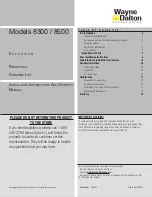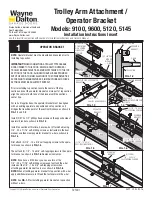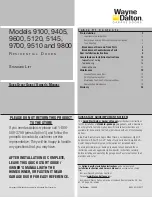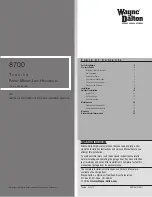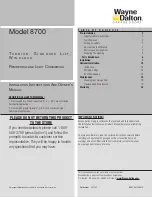
2
1
Pr
essur
e
switch N.C
Pr
essur
e
switch N.C
Photocell
N.C
Limit switch N.A
Fig.2
1
Control panel
Safety contact
Fig.1
The anti-crush system offers great security throughout the gate's path, both
when closing and opening.
PRESSURE SWITCH CONNECTION.
To access the connection and regulation of the pressure switch remove the
screws located at the rear holding the pressure switch and pull it down as
indicated by the arrow (Fig. 1).
The pressure switch is a normally closed contact (NC), which opens when
the pressure regulated by the adjustment screw is exceeded (Fig. 2, No. 1).
The system consists of two pressure switches (Fig. 2), which are responsi-
ble for controlling the circuit pressure of both manoeuvres independently
when opening and closing. These are connected in series (Fig .3-Fig. 4). The
connection of the pressure switch signal to the control panel is made through
the two-joint strip (Fig.2, No. 2) to the safety contact inlet of the panel. It is
necessary to incorporate a limit switch in the closure, normally open (NO)
as indicated by the diagram in Fig.3. Its function is to override the pressure
switch when the gate reaches the end of its path, and is exercising force on its
frame. Its proper placement is essential to prevent the gate from reversing the
manoeuvre. This will be how the motor will communicate to the control panel
that it can increase the pressure because it has reached the end of its path and
it is not an obstacle that must be released. In order to be able to do without a
limit switch when opening, it is necessary for the panel to have the option that
when the gate is opening and finds an obstacle, reverses the manoeuvre for
one or two seconds so as to release the obstacle and stop. If the panel does not
have this option, we will need to place another limit switch (N.A) in parallel
when opening. In this system, it is essential for the control panel to have an
inhibition of the pressure switch during the start of the closing manoeuvre.
At start-up, the motor requires an increase in force and this option allows an
increase in pressure avoiding an unwanted reversal.
PHOTOCELL CONNECTION
When the control panel does not have an exclusive inlet for the photocell we
can connect it in series with the pressure switches (Fig. 4).
REGULATION
To increase sensitivity, turn it counter-clockwise, and to decrease sensitivity,
turn it clockwise. Turning will be done in 15-degree turns.
Handling the pressure switch according to the type of opening:
-When the door opens inwards
(page 5, Fig. 2):
Opening adjustment, Fig. 1 pressure switch A (under the blue limiter)
Closing adjustment, Fig. 1 pressure switch B (under the red limiter)
-When the door opens outwards
(page 5, Fig. 2):
Opening adjustment, Fig. 1 pressure switch B (under the red limiter)
Closing adjustment, Fig. 1 pressure switch A (under the blue limiter)
IMPORTANT!
It must be handled in accordance with current standard UNE-
EN 12453.
Limit switch N.A
Fig.3
Control panel
Safety contact
ANTI-CRUSHING SYSTEM
Fig. 4
Pr
essur
e
switch N.C
Pr
essur
e
switch N.C
10 of 11













